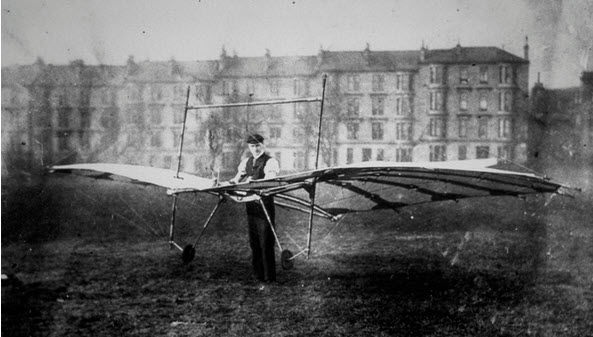You can be forgiven if you do not know who Percy Pilcher was. He was a British 19th-century aviation pioneer who was born in England and worked in Scotland. He has an important place in the early history of aviation – which was close to being much more significant if it were not for his untimely death.
Developing hang gliders in Scotland
Percy Pilcher was born in Bath in England in January 1867. His early years (from just 13 years old) saw him serving in the British Royal Navy, then later becoming an apprentice engineer working at the shipyards in Glasgow, Scotland. His interest and work in aviation began in 1891, after he became a lecturer at Glasgow University, teaching naval architecture and engineering. This was obviously very early days in aviation, years still before the powered flight began. There was plenty of experimentation and work with gliders and flight, however, and he became involved in this.
He built his first glider, the “Bat,” in 1895. After partnering with the experienced US aviation pioneer Otto Lilienthal (often referred to as the “father of aviation” with his successful first glider flights from 1981), he went on to produce three more gliders.
His most successful glider was the “Hawk,” which he developed by 1986, and set the distance record for flight (250 meters) when flown in England. The Hawk was made of fabric, bamboo, and wire (with some of the manufacturing and assembly being done by Percy’s sister, Ella Pilcher. It had a wingspan of 7.51 meters and a total length of 5.64 meters.
A vision for powered flight
As well as gliders and wing design, Pilcher was interested too in powered flight. He designed a triplane that he intended to power with a small combustion engine. Such an aircraft never flew, although his proposal was more than just ideas. He did significant work on engine possibilities. He worked with fellow engineer Walter Gordon Wilson on engine design (for both vehicles and aircraft), which led to the formation of the Wilson-Pilcher Company. Under Wilson’s charge, and after the death of Pilcher, the company produced its first automobile in 1900 and went on to produce several more. It was taken over by Sir W G Armstrong Whitworth & Co Ltd in 1904 (later to become part of Vickers-Armstrongs Limited).
Unfortunate death in a glider accident
It is reported that Pilcher completed his triplane prototype. However, before he was due to demonstrate it to the public for the first time, the engine developed crankshaft problems. The demonstration was on September 30th 1899. Instead of demonstrating the triplane, he instead flew the Hawk glider. Sadly, in the wet weather, the aircraft’s tail snapped (probably due to the saturated fabric). The glider crashed, and Pilcher was killed. Source/entire report: ‚Simple Flying‚.



US aviation pioneer Otto Lilienthal – laughing my head off. Lilienthal was German. His book on the physics of aviation („Der Vogelflug als Grundlage der Fliegekunst“) is regarded as the theoretical groundwork of aviation. Orville and Wilbur Wright comissioned an english translation of this book. It can be assumed all successful flight in those days was based on Otto’s findings.